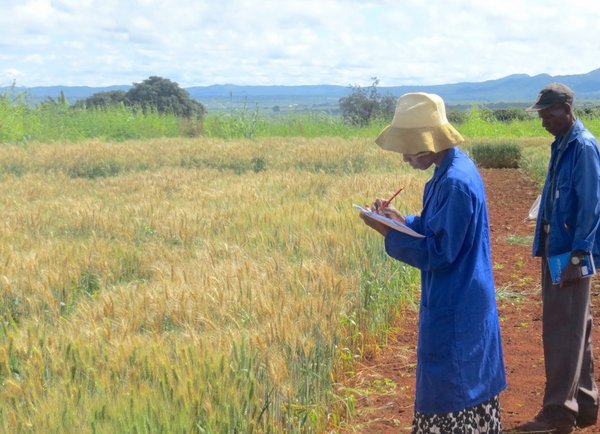 Read this article in French
Read this article in French- Share this article
- Subscribe to our newsletter
Wheat blast has made the intercontinental jump to Africa
The devastating wheat blast has arrived in Africa. According to an international team of scientists, the symptoms of wheat blast first appeared in Zambia during the 2018 rainy season, in experimental plots of the Zambian Agricultural Research Institute (ZARI) and on small-scale farms in the Mpika district, Muchinga province.
Wheat blast poses a serious threat to rain-fed wheat production in Zambia and raises the alarm for surrounding regions and countries on the African continent with similar environmental conditions. World-wide, 2.5 billion consumers depend on wheat as a staple food, and in recent years, several African countries have been actively working towards reducing dependence on wheat imports.
“This presents yet another challenging biotic constraint to rain-fed wheat production in Zambia,” said Batiseba Tembo, wheat breeder at ZARI and lead scientist on the study, which was releasedin the scientific journal PLoS Onein late September.
Researchers were initially confused when symptoms of the disease in the Mpika fields were first reported in the rainy season of 2018. Zambia has unique agro-climatic conditions, particularly in the rainfed wheat production system, and diseases such as spot blotch and Fusarium head blight are common.
“The crop had silvery white spikes and a green canopy, resulting in shrivelled grains or no grains at all …Within the span of seven days, a whole field can be attacked,” said Tembo. Samples were collected and analysed in the ZARI laboratory, and suspicions grew among researchers that this might be an entirely new disease.
A history of devastation
Wheat blast, caused by Magnaporthe oryzae pathotype Triticum (MoT), was initially discovered in Brazil in 1985, and within decades had affected around three million hectares of wheat in South America alone. The disease made its first intercontinental jump to Asia in 2016, causing a severe outbreak in Bangladesh, and reducing yield on average by as much as 51 per cent in the affected fields.
The disease has now become endemic to Bangladesh, and has potential to expand to similar warm, humid and wet environments in nearby India and Pakistan, as well as other regions of favourable disease conditions.
The fungal disease wheat blast spreads through infected seeds and crop residues as well as by spores that can travel long distances in the air. The spread of blast within Zambia is indicated by both mechanisms of expansion.
Tembo participated in the Basic Wheat Improvement Course at CIMMYT in Mexico, where she discussed the new disease. The scientists provided guidance and the molecular markers needed for the sample analysis in Zambia, and coordinated the analysis of the wheat disease samples at the USDA-ARS facility in Fort Detrick, Maryland, USA. All experiments confirmed the presence of Magnaporthe oryzae pathotype Triticum (MoT).
“This is a disaster which needs immediate attention,” warned Tembo. “Wheat blast has the potential to marginalise the growth of rain-fed wheat production in Zambia and in neighbouring countries as well.”
The CGIAR Research Program on Wheat
CIMMYT and the CGIAR Research Program on Wheat (WHEAT) are taking action on several fronts to combat wheat blast. Trainings, such as an international course led by the Bangladesh Wheat and Maize Research Institute (BWMRI) in collaboration with CIMMYT, WHEAT and others, invite international participants to gain new technical skills in blast diagnostics and treatment and understand different strategies being developed to mitigate the wheat blast threat. WHEAT scientists and partners are also working quickly to study genetic factors that increase resistance to the disease and develop early warning systems, among other research interventions.
“In the case of Zambia, a set of research outcomes, including the development of resistant varieties, identification of effective fungicides, agronomic measures, and new findings in the epidemiology of disease development, will be helpful in mitigating wheat blast in Zambia,” noted Pawan Singh, head of Wheat Pathology at CIMMYT.
(CIMMYT/wi)
Read the study: Detection and characterization of fungus (Magnaporthe oryzae pathotype Triticum) causing wheat blast disease on rain-fed grown wheat (Triticum aestivum L.) in Zambia. Published: September 21st, 2020





Add a comment
Be the First to Comment